Report: Social Care for Young Adults with Learning Disabilities
VerifiedAdded on 2022/08/20
|9
|1591
|11
Report
AI Summary
This report delves into the provision of social care for young adults with learning disabilities, focusing on the perspective of social care providers. It begins by defining social care and its role in supporting individuals to improve their quality of life. The report analyzes demographic patterns, trends, and changes in the UK, specifically in Barking and Dagenham, examining the increasing population and its impact. It outlines the ranges of social care provisions, including statutory, voluntary, informal, and private services, and identifies the various organizations involved. Furthermore, it highlights the challenges faced in delivering these services, such as physical, financial, and social barriers, and emphasizes the need for holistic approaches and improved communication. The report concludes by underscoring the importance of social care for vulnerable young adults and the need to address associated issues to ensure effective service access. The report references relevant sources to support its findings.
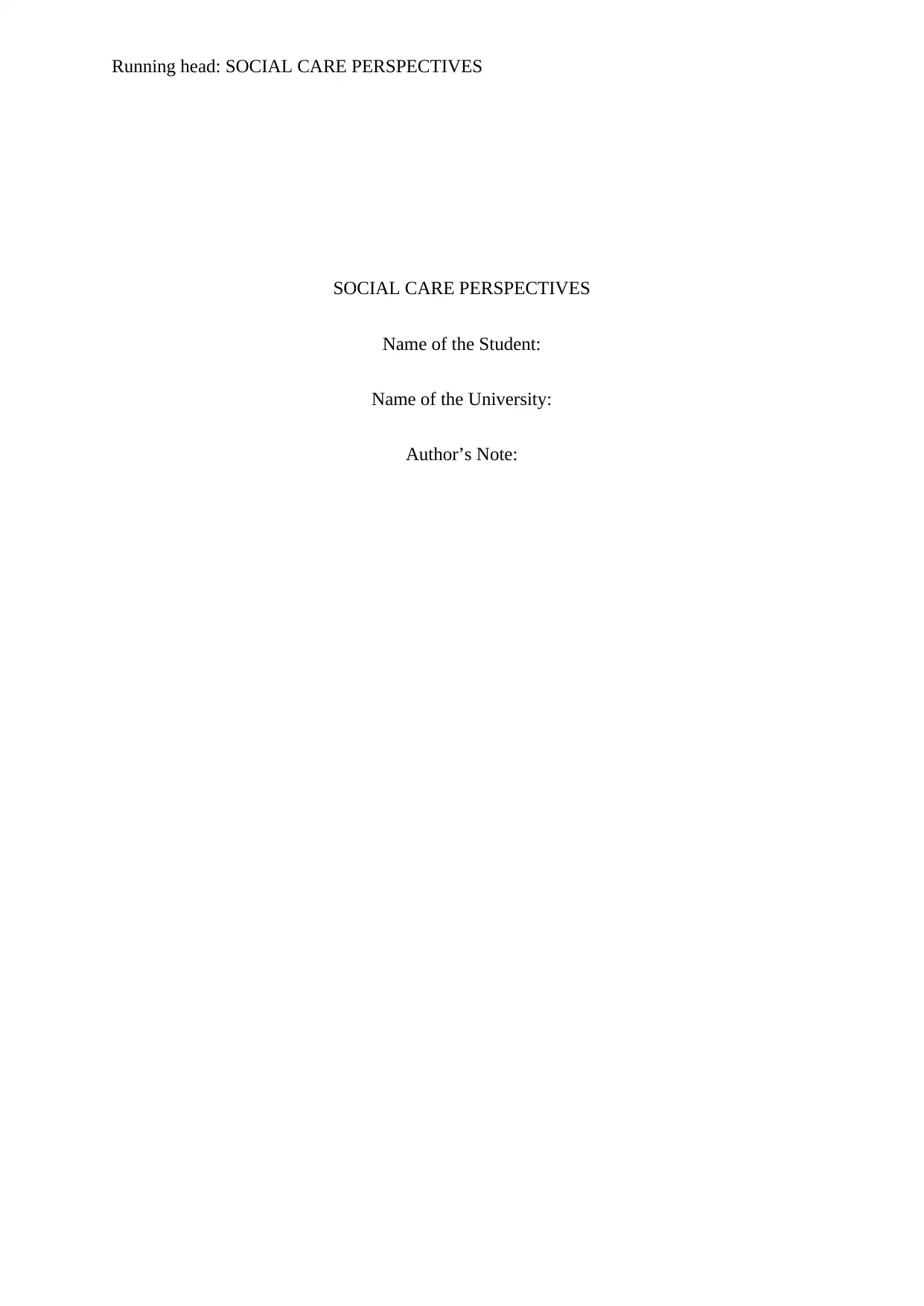
Running head: SOCIAL CARE PERSPECTIVES
SOCIAL CARE PERSPECTIVES
Name of the Student:
Name of the University:
Author’s Note:
SOCIAL CARE PERSPECTIVES
Name of the Student:
Name of the University:
Author’s Note:
Paraphrase This Document
Need a fresh take? Get an instant paraphrase of this document with our AI Paraphraser
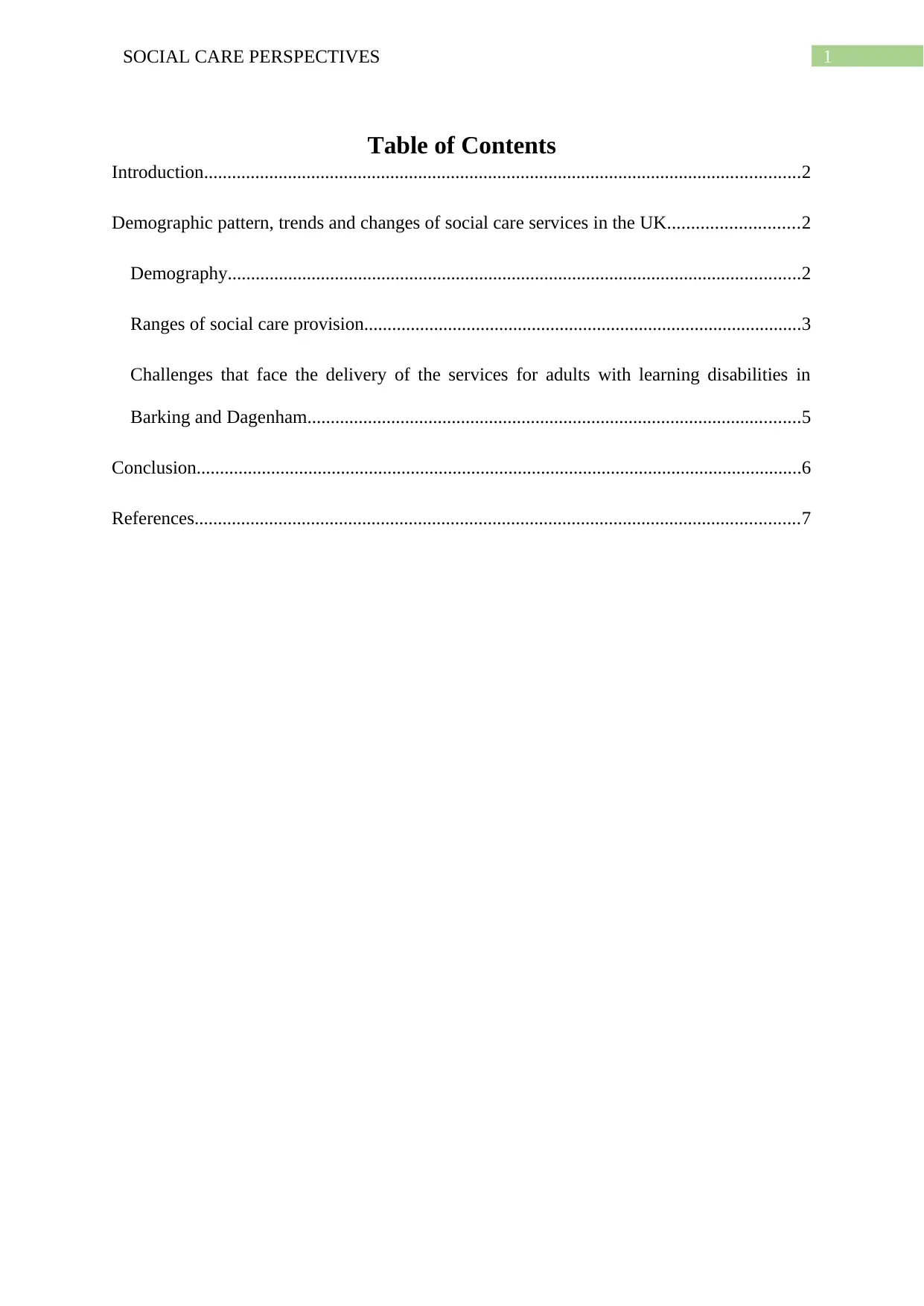
1SOCIAL CARE PERSPECTIVES
Table of Contents
Introduction................................................................................................................................2
Demographic pattern, trends and changes of social care services in the UK............................2
Demography...........................................................................................................................2
Ranges of social care provision..............................................................................................3
Challenges that face the delivery of the services for adults with learning disabilities in
Barking and Dagenham..........................................................................................................5
Conclusion..................................................................................................................................6
References..................................................................................................................................7
Table of Contents
Introduction................................................................................................................................2
Demographic pattern, trends and changes of social care services in the UK............................2
Demography...........................................................................................................................2
Ranges of social care provision..............................................................................................3
Challenges that face the delivery of the services for adults with learning disabilities in
Barking and Dagenham..........................................................................................................5
Conclusion..................................................................................................................................6
References..................................................................................................................................7
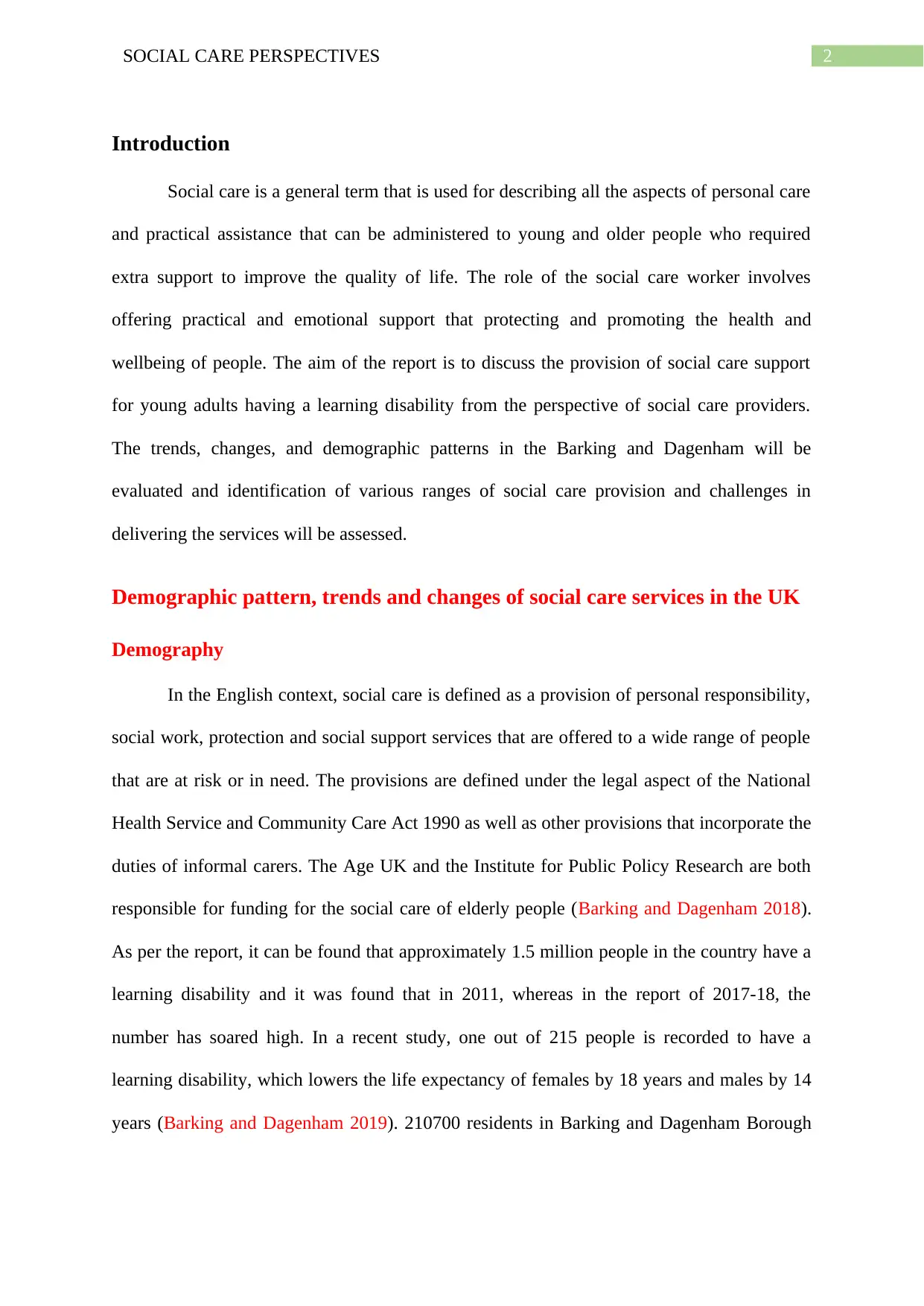
2SOCIAL CARE PERSPECTIVES
Introduction
Social care is a general term that is used for describing all the aspects of personal care
and practical assistance that can be administered to young and older people who required
extra support to improve the quality of life. The role of the social care worker involves
offering practical and emotional support that protecting and promoting the health and
wellbeing of people. The aim of the report is to discuss the provision of social care support
for young adults having a learning disability from the perspective of social care providers.
The trends, changes, and demographic patterns in the Barking and Dagenham will be
evaluated and identification of various ranges of social care provision and challenges in
delivering the services will be assessed.
Demographic pattern, trends and changes of social care services in the UK
Demography
In the English context, social care is defined as a provision of personal responsibility,
social work, protection and social support services that are offered to a wide range of people
that are at risk or in need. The provisions are defined under the legal aspect of the National
Health Service and Community Care Act 1990 as well as other provisions that incorporate the
duties of informal carers. The Age UK and the Institute for Public Policy Research are both
responsible for funding for the social care of elderly people (Barking and Dagenham 2018).
As per the report, it can be found that approximately 1.5 million people in the country have a
learning disability and it was found that in 2011, whereas in the report of 2017-18, the
number has soared high. In a recent study, one out of 215 people is recorded to have a
learning disability, which lowers the life expectancy of females by 18 years and males by 14
years (Barking and Dagenham 2019). 210700 residents in Barking and Dagenham Borough
Introduction
Social care is a general term that is used for describing all the aspects of personal care
and practical assistance that can be administered to young and older people who required
extra support to improve the quality of life. The role of the social care worker involves
offering practical and emotional support that protecting and promoting the health and
wellbeing of people. The aim of the report is to discuss the provision of social care support
for young adults having a learning disability from the perspective of social care providers.
The trends, changes, and demographic patterns in the Barking and Dagenham will be
evaluated and identification of various ranges of social care provision and challenges in
delivering the services will be assessed.
Demographic pattern, trends and changes of social care services in the UK
Demography
In the English context, social care is defined as a provision of personal responsibility,
social work, protection and social support services that are offered to a wide range of people
that are at risk or in need. The provisions are defined under the legal aspect of the National
Health Service and Community Care Act 1990 as well as other provisions that incorporate the
duties of informal carers. The Age UK and the Institute for Public Policy Research are both
responsible for funding for the social care of elderly people (Barking and Dagenham 2018).
As per the report, it can be found that approximately 1.5 million people in the country have a
learning disability and it was found that in 2011, whereas in the report of 2017-18, the
number has soared high. In a recent study, one out of 215 people is recorded to have a
learning disability, which lowers the life expectancy of females by 18 years and males by 14
years (Barking and Dagenham 2019). 210700 residents in Barking and Dagenham Borough
⊘ This is a preview!⊘
Do you want full access?
Subscribe today to unlock all pages.

Trusted by 1+ million students worldwide
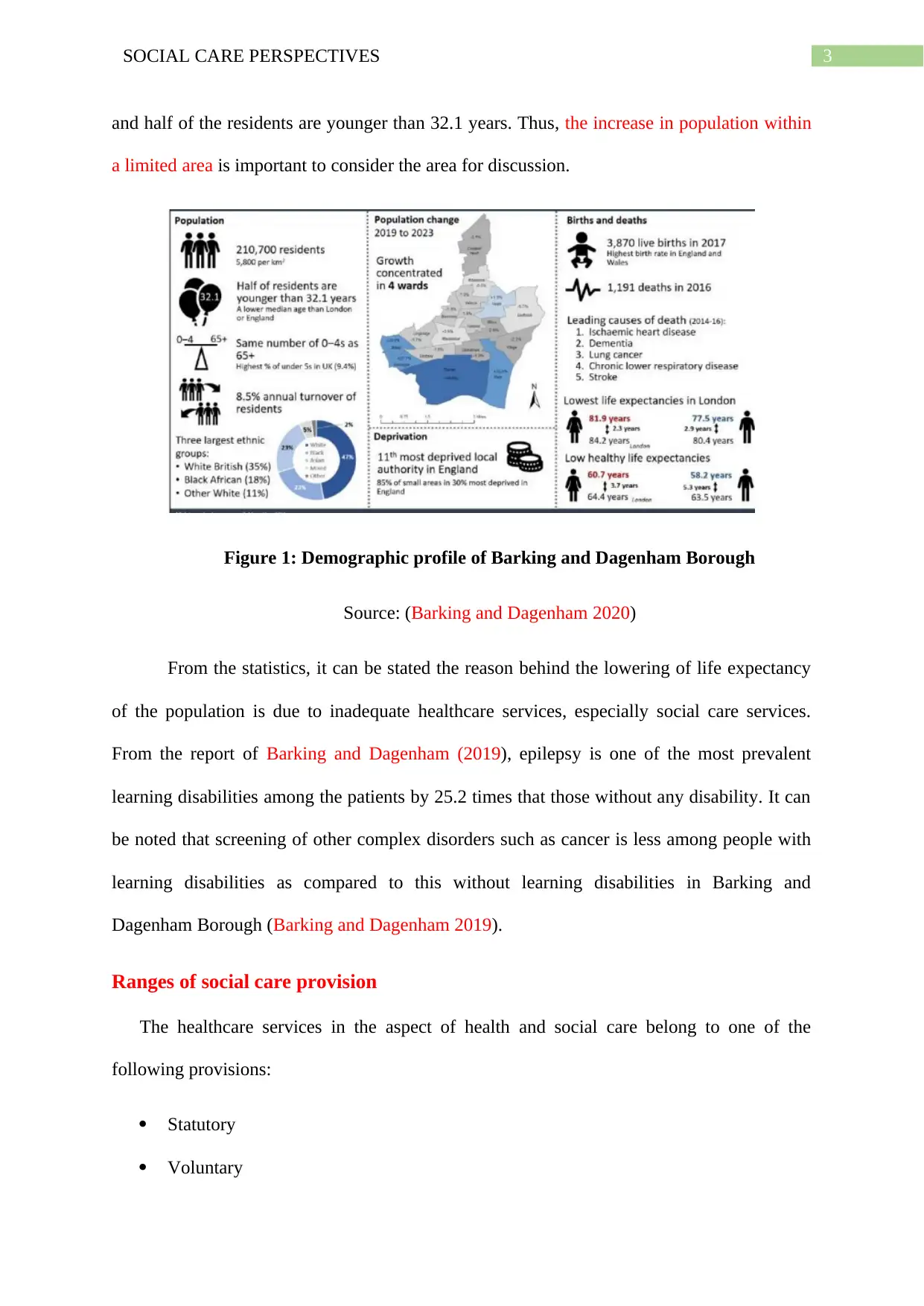
3SOCIAL CARE PERSPECTIVES
and half of the residents are younger than 32.1 years. Thus, the increase in population within
a limited area is important to consider the area for discussion.
Figure 1: Demographic profile of Barking and Dagenham Borough
Source: (Barking and Dagenham 2020)
From the statistics, it can be stated the reason behind the lowering of life expectancy
of the population is due to inadequate healthcare services, especially social care services.
From the report of Barking and Dagenham (2019), epilepsy is one of the most prevalent
learning disabilities among the patients by 25.2 times that those without any disability. It can
be noted that screening of other complex disorders such as cancer is less among people with
learning disabilities as compared to this without learning disabilities in Barking and
Dagenham Borough (Barking and Dagenham 2019).
Ranges of social care provision
The healthcare services in the aspect of health and social care belong to one of the
following provisions:
Statutory
Voluntary
and half of the residents are younger than 32.1 years. Thus, the increase in population within
a limited area is important to consider the area for discussion.
Figure 1: Demographic profile of Barking and Dagenham Borough
Source: (Barking and Dagenham 2020)
From the statistics, it can be stated the reason behind the lowering of life expectancy
of the population is due to inadequate healthcare services, especially social care services.
From the report of Barking and Dagenham (2019), epilepsy is one of the most prevalent
learning disabilities among the patients by 25.2 times that those without any disability. It can
be noted that screening of other complex disorders such as cancer is less among people with
learning disabilities as compared to this without learning disabilities in Barking and
Dagenham Borough (Barking and Dagenham 2019).
Ranges of social care provision
The healthcare services in the aspect of health and social care belong to one of the
following provisions:
Statutory
Voluntary
Paraphrase This Document
Need a fresh take? Get an instant paraphrase of this document with our AI Paraphraser
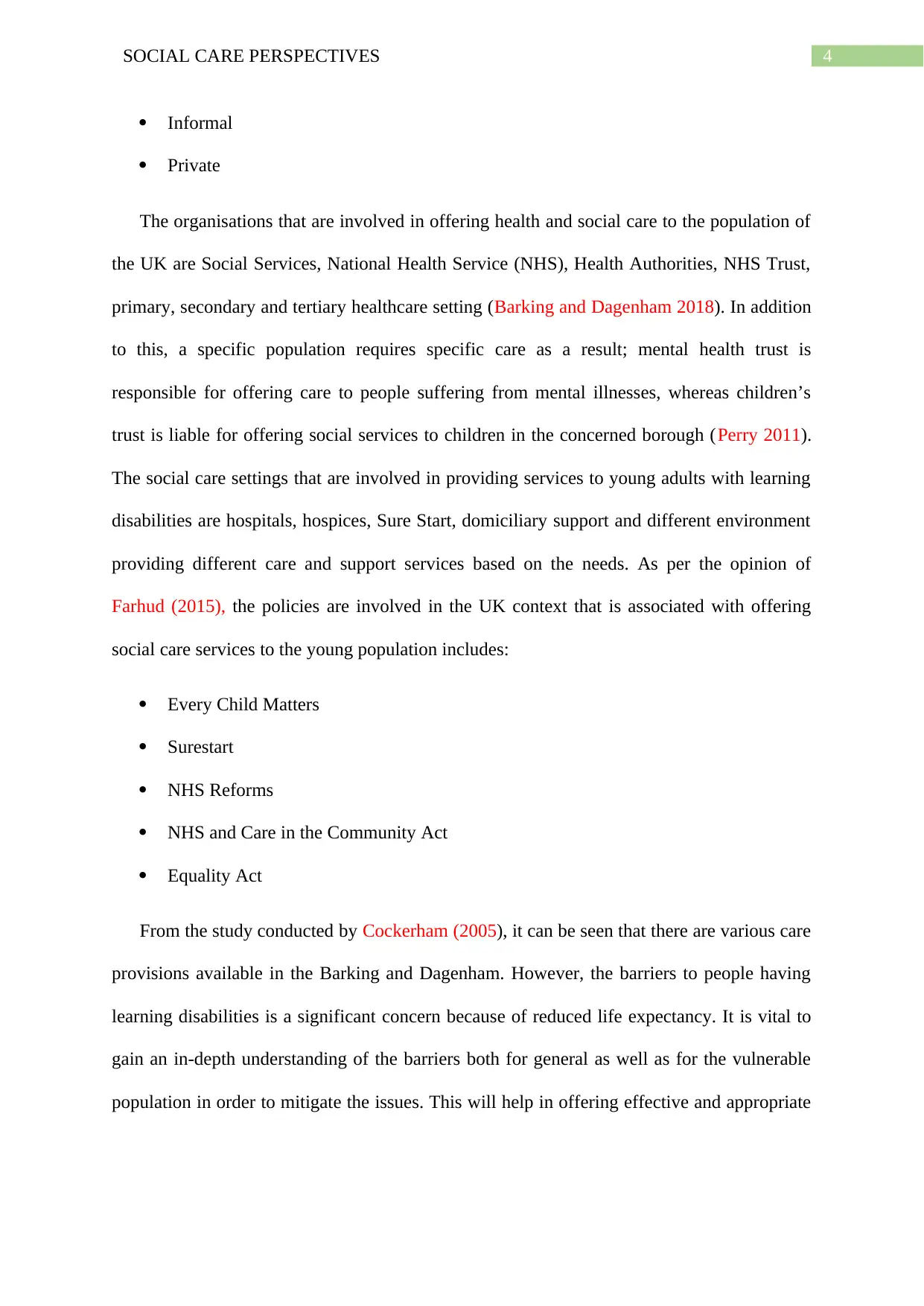
4SOCIAL CARE PERSPECTIVES
Informal
Private
The organisations that are involved in offering health and social care to the population of
the UK are Social Services, National Health Service (NHS), Health Authorities, NHS Trust,
primary, secondary and tertiary healthcare setting (Barking and Dagenham 2018). In addition
to this, a specific population requires specific care as a result; mental health trust is
responsible for offering care to people suffering from mental illnesses, whereas children’s
trust is liable for offering social services to children in the concerned borough (Perry 2011).
The social care settings that are involved in providing services to young adults with learning
disabilities are hospitals, hospices, Sure Start, domiciliary support and different environment
providing different care and support services based on the needs. As per the opinion of
Farhud (2015), the policies are involved in the UK context that is associated with offering
social care services to the young population includes:
Every Child Matters
Surestart
NHS Reforms
NHS and Care in the Community Act
Equality Act
From the study conducted by Cockerham (2005), it can be seen that there are various care
provisions available in the Barking and Dagenham. However, the barriers to people having
learning disabilities is a significant concern because of reduced life expectancy. It is vital to
gain an in-depth understanding of the barriers both for general as well as for the vulnerable
population in order to mitigate the issues. This will help in offering effective and appropriate
Informal
Private
The organisations that are involved in offering health and social care to the population of
the UK are Social Services, National Health Service (NHS), Health Authorities, NHS Trust,
primary, secondary and tertiary healthcare setting (Barking and Dagenham 2018). In addition
to this, a specific population requires specific care as a result; mental health trust is
responsible for offering care to people suffering from mental illnesses, whereas children’s
trust is liable for offering social services to children in the concerned borough (Perry 2011).
The social care settings that are involved in providing services to young adults with learning
disabilities are hospitals, hospices, Sure Start, domiciliary support and different environment
providing different care and support services based on the needs. As per the opinion of
Farhud (2015), the policies are involved in the UK context that is associated with offering
social care services to the young population includes:
Every Child Matters
Surestart
NHS Reforms
NHS and Care in the Community Act
Equality Act
From the study conducted by Cockerham (2005), it can be seen that there are various care
provisions available in the Barking and Dagenham. However, the barriers to people having
learning disabilities is a significant concern because of reduced life expectancy. It is vital to
gain an in-depth understanding of the barriers both for general as well as for the vulnerable
population in order to mitigate the issues. This will help in offering effective and appropriate
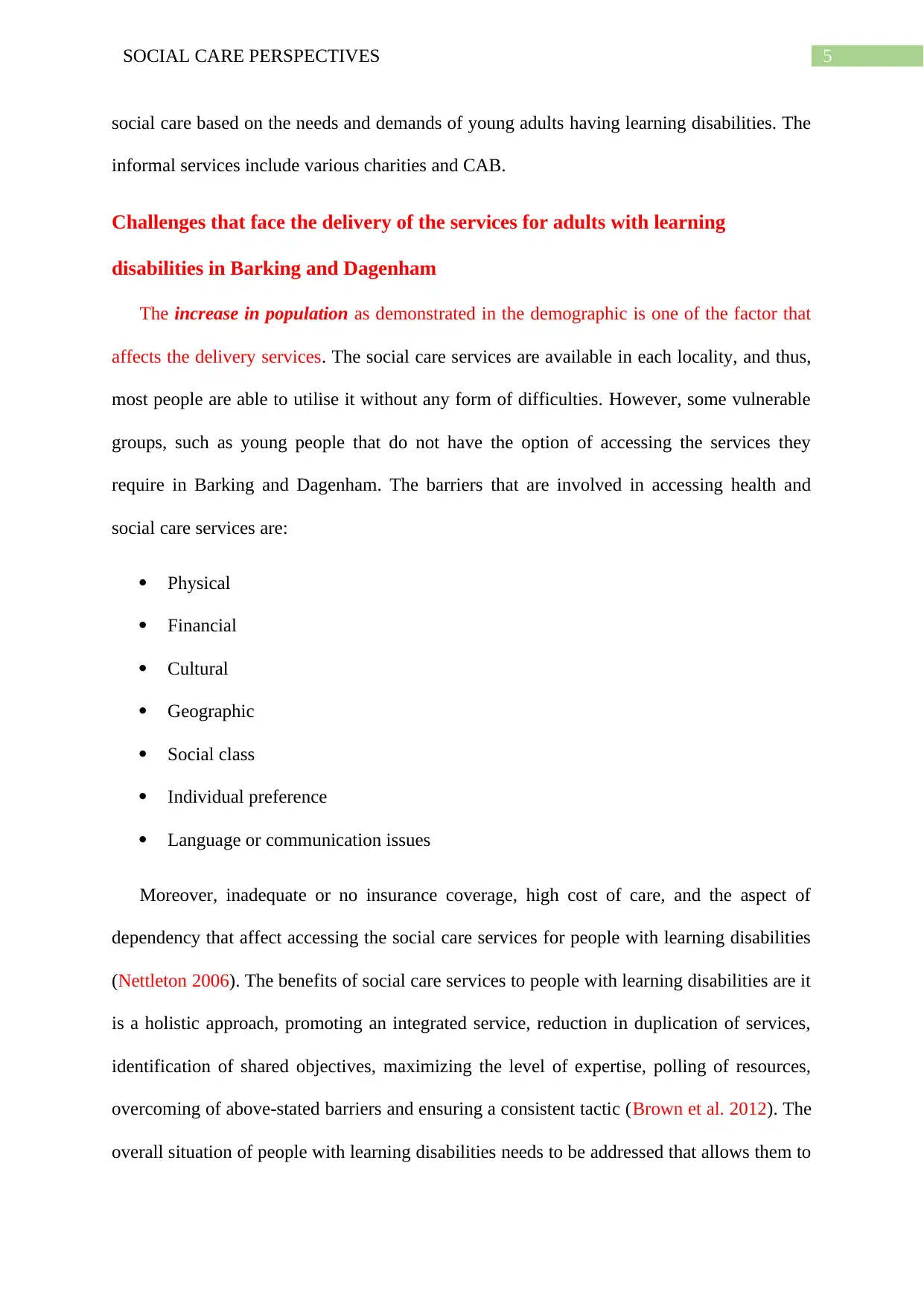
5SOCIAL CARE PERSPECTIVES
social care based on the needs and demands of young adults having learning disabilities. The
informal services include various charities and CAB.
Challenges that face the delivery of the services for adults with learning
disabilities in Barking and Dagenham
The increase in population as demonstrated in the demographic is one of the factor that
affects the delivery services. The social care services are available in each locality, and thus,
most people are able to utilise it without any form of difficulties. However, some vulnerable
groups, such as young people that do not have the option of accessing the services they
require in Barking and Dagenham. The barriers that are involved in accessing health and
social care services are:
Physical
Financial
Cultural
Geographic
Social class
Individual preference
Language or communication issues
Moreover, inadequate or no insurance coverage, high cost of care, and the aspect of
dependency that affect accessing the social care services for people with learning disabilities
(Nettleton 2006). The benefits of social care services to people with learning disabilities are it
is a holistic approach, promoting an integrated service, reduction in duplication of services,
identification of shared objectives, maximizing the level of expertise, polling of resources,
overcoming of above-stated barriers and ensuring a consistent tactic (Brown et al. 2012). The
overall situation of people with learning disabilities needs to be addressed that allows them to
social care based on the needs and demands of young adults having learning disabilities. The
informal services include various charities and CAB.
Challenges that face the delivery of the services for adults with learning
disabilities in Barking and Dagenham
The increase in population as demonstrated in the demographic is one of the factor that
affects the delivery services. The social care services are available in each locality, and thus,
most people are able to utilise it without any form of difficulties. However, some vulnerable
groups, such as young people that do not have the option of accessing the services they
require in Barking and Dagenham. The barriers that are involved in accessing health and
social care services are:
Physical
Financial
Cultural
Geographic
Social class
Individual preference
Language or communication issues
Moreover, inadequate or no insurance coverage, high cost of care, and the aspect of
dependency that affect accessing the social care services for people with learning disabilities
(Nettleton 2006). The benefits of social care services to people with learning disabilities are it
is a holistic approach, promoting an integrated service, reduction in duplication of services,
identification of shared objectives, maximizing the level of expertise, polling of resources,
overcoming of above-stated barriers and ensuring a consistent tactic (Brown et al. 2012). The
overall situation of people with learning disabilities needs to be addressed that allows them to
⊘ This is a preview!⊘
Do you want full access?
Subscribe today to unlock all pages.

Trusted by 1+ million students worldwide
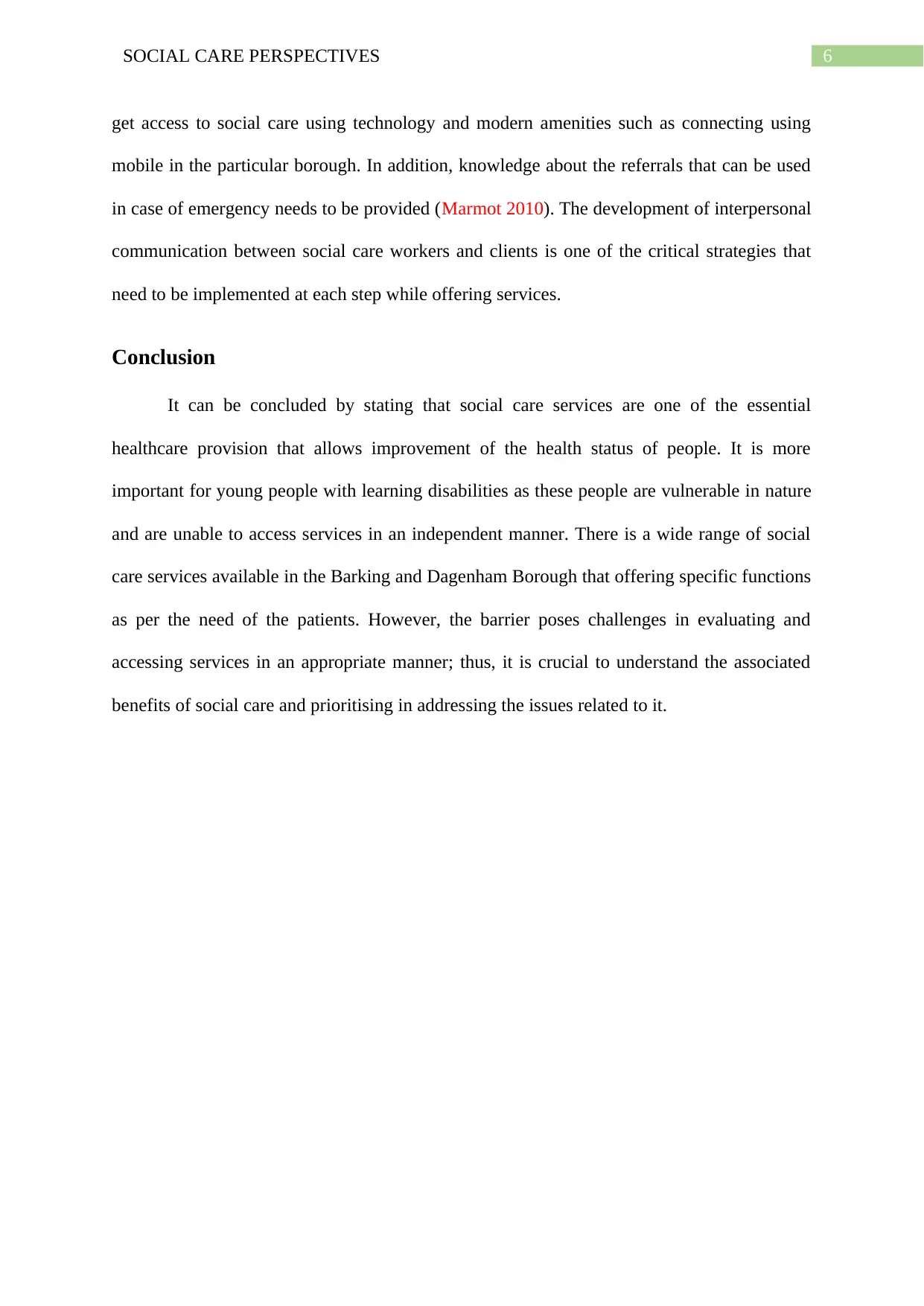
6SOCIAL CARE PERSPECTIVES
get access to social care using technology and modern amenities such as connecting using
mobile in the particular borough. In addition, knowledge about the referrals that can be used
in case of emergency needs to be provided (Marmot 2010). The development of interpersonal
communication between social care workers and clients is one of the critical strategies that
need to be implemented at each step while offering services.
Conclusion
It can be concluded by stating that social care services are one of the essential
healthcare provision that allows improvement of the health status of people. It is more
important for young people with learning disabilities as these people are vulnerable in nature
and are unable to access services in an independent manner. There is a wide range of social
care services available in the Barking and Dagenham Borough that offering specific functions
as per the need of the patients. However, the barrier poses challenges in evaluating and
accessing services in an appropriate manner; thus, it is crucial to understand the associated
benefits of social care and prioritising in addressing the issues related to it.
get access to social care using technology and modern amenities such as connecting using
mobile in the particular borough. In addition, knowledge about the referrals that can be used
in case of emergency needs to be provided (Marmot 2010). The development of interpersonal
communication between social care workers and clients is one of the critical strategies that
need to be implemented at each step while offering services.
Conclusion
It can be concluded by stating that social care services are one of the essential
healthcare provision that allows improvement of the health status of people. It is more
important for young people with learning disabilities as these people are vulnerable in nature
and are unable to access services in an independent manner. There is a wide range of social
care services available in the Barking and Dagenham Borough that offering specific functions
as per the need of the patients. However, the barrier poses challenges in evaluating and
accessing services in an appropriate manner; thus, it is crucial to understand the associated
benefits of social care and prioritising in addressing the issues related to it.
Paraphrase This Document
Need a fresh take? Get an instant paraphrase of this document with our AI Paraphraser
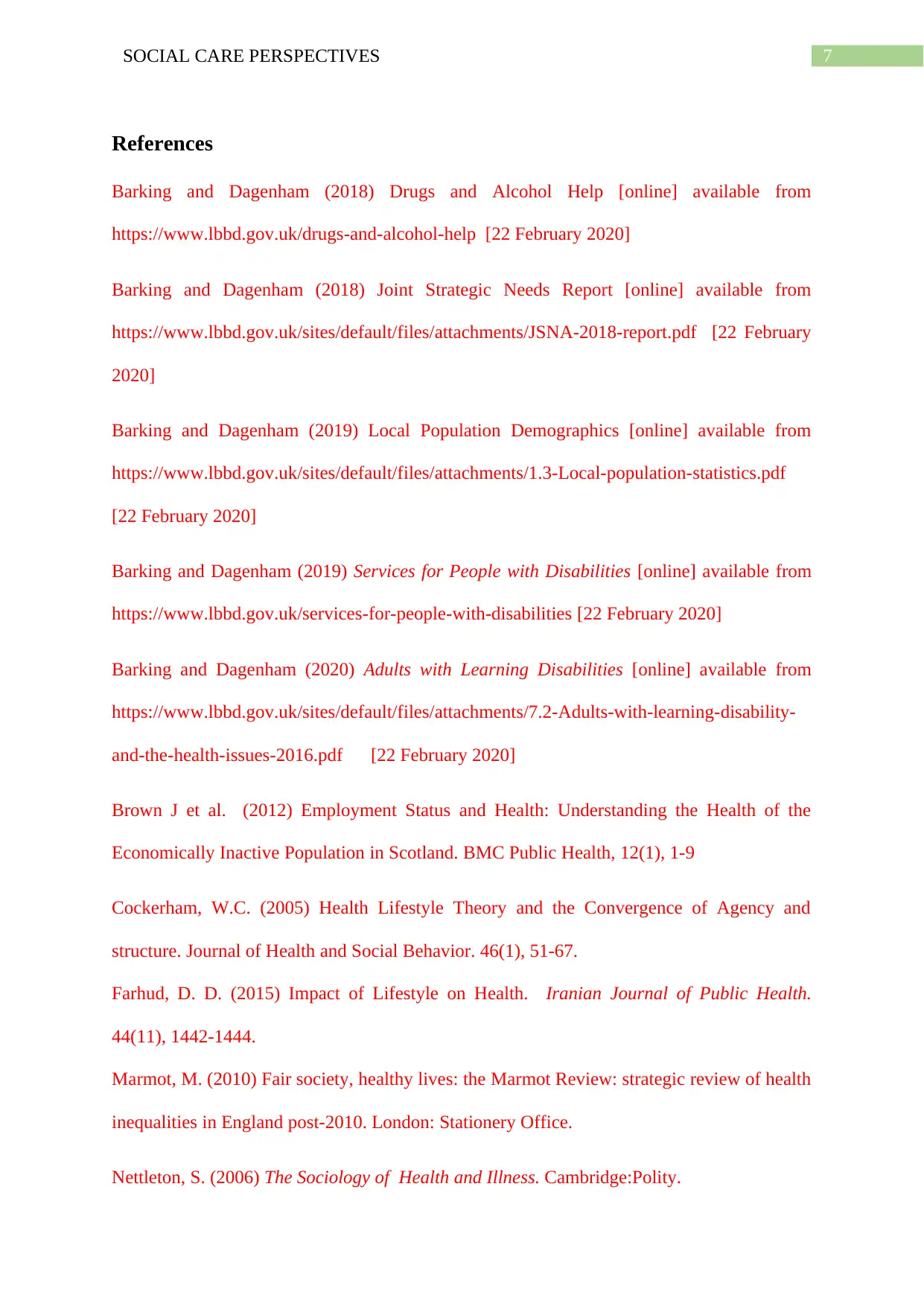
7SOCIAL CARE PERSPECTIVES
References
Barking and Dagenham (2018) Drugs and Alcohol Help [online] available from
https://www.lbbd.gov.uk/drugs-and-alcohol-help [22 February 2020]
Barking and Dagenham (2018) Joint Strategic Needs Report [online] available from
https://www.lbbd.gov.uk/sites/default/files/attachments/JSNA-2018-report.pdf [22 February
2020]
Barking and Dagenham (2019) Local Population Demographics [online] available from
https://www.lbbd.gov.uk/sites/default/files/attachments/1.3-Local-population-statistics.pdf
[22 February 2020]
Barking and Dagenham (2019) Services for People with Disabilities [online] available from
https://www.lbbd.gov.uk/services-for-people-with-disabilities [22 February 2020]
Barking and Dagenham (2020) Adults with Learning Disabilities [online] available from
https://www.lbbd.gov.uk/sites/default/files/attachments/7.2-Adults-with-learning-disability-
and-the-health-issues-2016.pdf [22 February 2020]
Brown J et al. (2012) Employment Status and Health: Understanding the Health of the
Economically Inactive Population in Scotland. BMC Public Health, 12(1), 1-9
Cockerham, W.C. (2005) Health Lifestyle Theory and the Convergence of Agency and
structure. Journal of Health and Social Behavior. 46(1), 51-67.
Farhud, D. D. (2015) Impact of Lifestyle on Health. Iranian Journal of Public Health.
44(11), 1442-1444.
Marmot, M. (2010) Fair society, healthy lives: the Marmot Review: strategic review of health
inequalities in England post-2010. London: Stationery Office.
Nettleton, S. (2006) The Sociology of Health and Illness. Cambridge:Polity.
References
Barking and Dagenham (2018) Drugs and Alcohol Help [online] available from
https://www.lbbd.gov.uk/drugs-and-alcohol-help [22 February 2020]
Barking and Dagenham (2018) Joint Strategic Needs Report [online] available from
https://www.lbbd.gov.uk/sites/default/files/attachments/JSNA-2018-report.pdf [22 February
2020]
Barking and Dagenham (2019) Local Population Demographics [online] available from
https://www.lbbd.gov.uk/sites/default/files/attachments/1.3-Local-population-statistics.pdf
[22 February 2020]
Barking and Dagenham (2019) Services for People with Disabilities [online] available from
https://www.lbbd.gov.uk/services-for-people-with-disabilities [22 February 2020]
Barking and Dagenham (2020) Adults with Learning Disabilities [online] available from
https://www.lbbd.gov.uk/sites/default/files/attachments/7.2-Adults-with-learning-disability-
and-the-health-issues-2016.pdf [22 February 2020]
Brown J et al. (2012) Employment Status and Health: Understanding the Health of the
Economically Inactive Population in Scotland. BMC Public Health, 12(1), 1-9
Cockerham, W.C. (2005) Health Lifestyle Theory and the Convergence of Agency and
structure. Journal of Health and Social Behavior. 46(1), 51-67.
Farhud, D. D. (2015) Impact of Lifestyle on Health. Iranian Journal of Public Health.
44(11), 1442-1444.
Marmot, M. (2010) Fair society, healthy lives: the Marmot Review: strategic review of health
inequalities in England post-2010. London: Stationery Office.
Nettleton, S. (2006) The Sociology of Health and Illness. Cambridge:Polity.
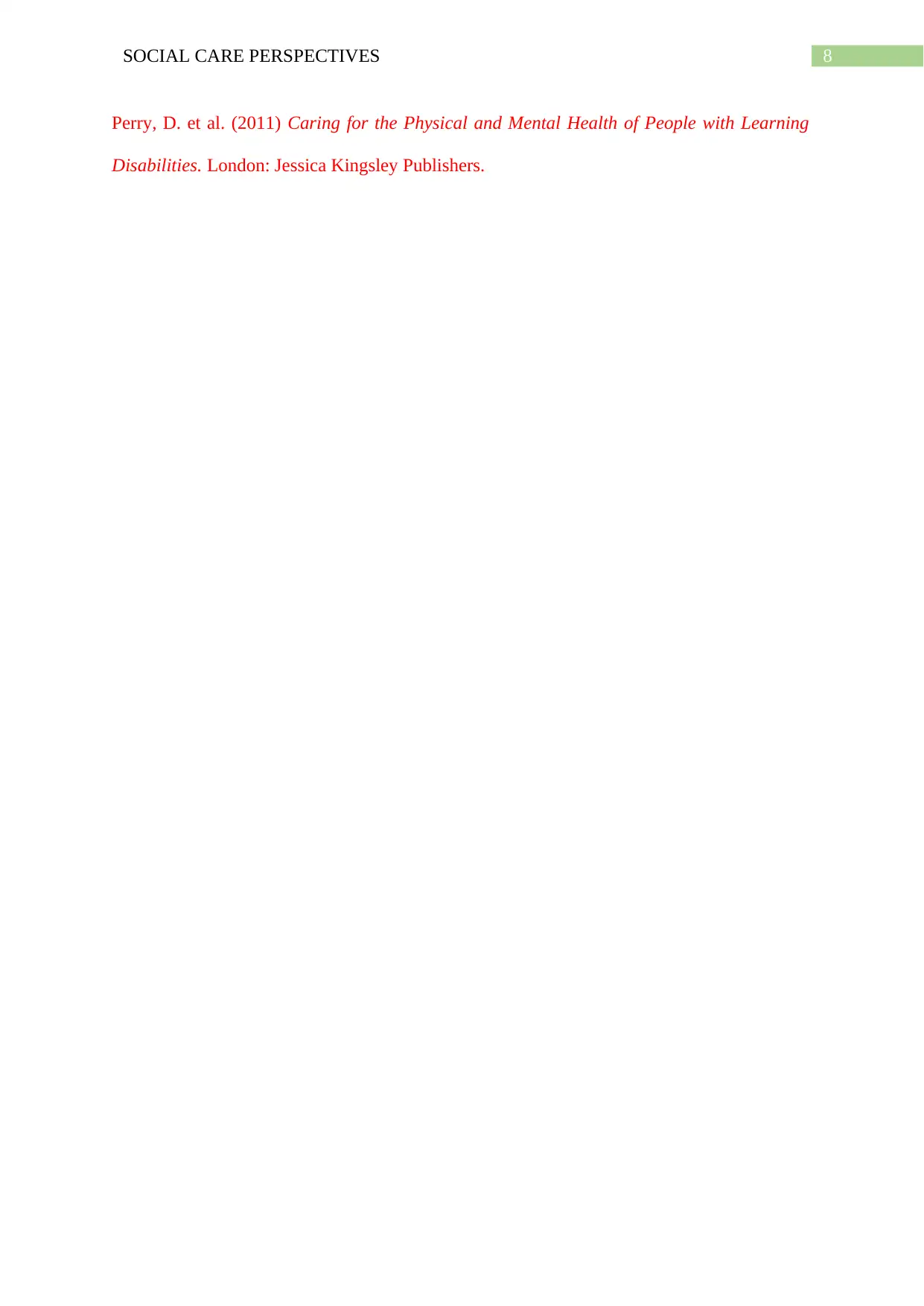
8SOCIAL CARE PERSPECTIVES
Perry, D. et al. (2011) Caring for the Physical and Mental Health of People with Learning
Disabilities. London: Jessica Kingsley Publishers.
Perry, D. et al. (2011) Caring for the Physical and Mental Health of People with Learning
Disabilities. London: Jessica Kingsley Publishers.
⊘ This is a preview!⊘
Do you want full access?
Subscribe today to unlock all pages.

Trusted by 1+ million students worldwide
1 out of 9
Related Documents
Your All-in-One AI-Powered Toolkit for Academic Success.
+13062052269
info@desklib.com
Available 24*7 on WhatsApp / Email
![[object Object]](/_next/static/media/star-bottom.7253800d.svg)
Unlock your academic potential
Copyright © 2020–2025 A2Z Services. All Rights Reserved. Developed and managed by ZUCOL.





